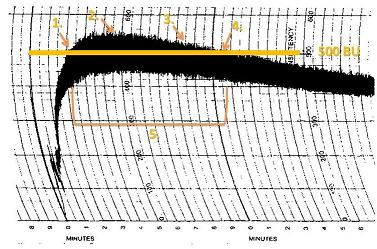User:Kalossoter/Farinograph
In Baking, a Farinograph measures specific properties of flour. The Farinograph is used as a tool to measure shear (fluid) and Viscosity of a mixture of flour and water. The primary units of the farinograph are Brabender Units, an arbitrary unit of measuring the viscosity of a fluid.[1] The Farinograph is directly related to the invention of the Brabender Plastograph invented by Carl Wilhelm Brabender. Its use has been specialized for the baking industry and is used across the world as an objective measurement of a variety of flours.
The results of the Farinograph assist in formulation of end products through the following methods:
- Measure water absorption by a flour.
- Dough viscosity, including peak water to gluten ratio prior to gluten breakdown.
- Peak mixing time to arrive at desired water/gluten ratio.
- The stability of flour under mixing.
- The tolerance of a flour's gluten.
Method[edit]
The farinograph is drawn on a curved graph with the vertical axis labeled in Brabender Units (BU) and the horizontal axis labeled as time in minutes. The graph is generally hockey-stick shaped, with the curve being more or less acute depending on the strength of the gluten in the flour.
The points of interest on the graph are fivefold:
1. Arrival Time (Absorption) - Absorption is the point chosen by the baking industry which represents a target water to flour ratio in bread. This ratio is marked at the 500 BU line and is taken as a rule of thumb for desired taste, texture, and dough performance during proofing and baking. All other measurements are based on this 500 BU standard. (For comparison, the accepted BU is 1000 or greater for noodles[2].
Thus on the graph above, Arrival time is the point on the graph where the top of the curve reaches the 500 BU point and indicates the rate of absorption (minutes/BU).
2. Peak time - Peak time is reached at the highest point on the curve, and indicates when the dough has reached is maximum viscosity before gluten strands begin to break down.
3. Mixing Tolerance Index (MTI) - MTI is found by taking the difference in BU between the peak time point (on the graph above 3 minutes, 30 seconds) and 5 minutes after peak time is reached. This is used by bakers to determine the amount that a dough will soften over a period of mixing. MTI may be expressed as a value in BU or as a percentage of BU lost over time ().
4. Departure Time - Departure time is defined as the point at which the top of the curve goes below the 500 BU line. This point is generally considered the point at which gluten is breaking down and dough has become over mixed.
5. Stability - Stability is the point between arrival time and departure time and generally indicates the strength of a flour (how much gluten a flour has and how strong it is).
The graph above is a gluten rich bread flour, as its stability time is relatively long and the MTI is still above the 500 BU line. A weaker flour, such as a cake or pastry flour with a much lower gluten content would have a much steeper decline after peak time.
Applications[edit]
The Farinograph is used worldwide by bakers and food technicians in building bakery formulations. The farinograph gives the baker a good snapshot of the flour's properties and how the flour will react in different stages of baking. It assists the baker in choosing the right flour for the job he is trying to complete.
The industrial application of these 5 points is far reaching. A baker may use, for example, the arrival time as a bare minimum time when planning full product floor time for a batch of dough. A baker may also use MTI as guideline to judge the response of a dough to the addition of other ingredients. Peak time may be used as a target mix time for optimal gluten structure and resilience. Stability may be used as a method of determining desired cell structure before irreparable gluten breakdown occurs.
References[edit]
- Starch in food: structure, function and applications. Ann-Charlotte Eliasson. CRC Press, 2004. ISBN 0849325552, 9780849325557
- US Department of Agriculture Agricultural Research Service.
- American Association of Cereal Chemists


